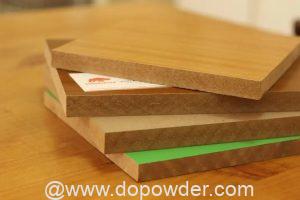Low Temperature Cure Powder Coatings For Heat-sensitive Substrates

Low Temperature Cure Powder Coatings For Heat-sensitive Substrates
For application on heat-sensitive substrates like MDF, the powder must cure below 302°F (150°C) or even 212°F (100°C). Several approaches have been developed to achieve this goal, ranging from low-temperature-cure conventional chemistries to radiation-curable evolving chemistries.
A vast number of published articles and patents have confirmed the ability of UV-curable technologies to produce glossy, smooth coatings on MDF within three to five minutes of process time.8The main advantages of UV-cured powders include higher productivity and space savings due to shorter curing times at lower temperatures, excellent surface finish and film properties, a reduced risk of damage to the MDF due to a reduced peak temperature and, most importantly, a reduced sensitivity to outgassing. However, UV technologies also have a number of drawbacks, including an inability to produce thick or matte coatings, shade specificity (particularly yellow shades), instability in tropical climates, higher material costs and higher capital equipment requirements. UV systems also present processing difficulties during conventional extrusion due their lower glass transition temperature. These limitations have deterred the large-scale commercialization of this technology.
In comparison, standard thermal-cure powders do not have any limitations in shades, effect finishes, coating thickness, product stability in warm climates, object shapes, etc., and they can be adapted to conventional extrusion and application equipment. Their only drawback is their higher curing temperature. For this reason, the ideal approach to ensure broad-based acceptability would be to develop a suitable low temperature powder coating technology in the existing thermal-cure chemistries.
In a review of the research work conducted with low-temperature-cure powders, systems using glycidyl methacrylic (GMA) acrylics – a mixture of amorphous and crystalline epoxy and polyester resin systems, along with suitable curing catalysts – have been most successful. The GMA acrylics provide excellent weatherability, film appearance, film clarity and color retention, as well as the absence of byproducts during cure and the lowest curing temperature. Commercial application of these low-temperature-cure technologies has been realized at several automotive plants, including General Motors, BMW and Chrysler, and many more are on the horizon in near future to conform to more stringent emission regulations.

Comments are Closed